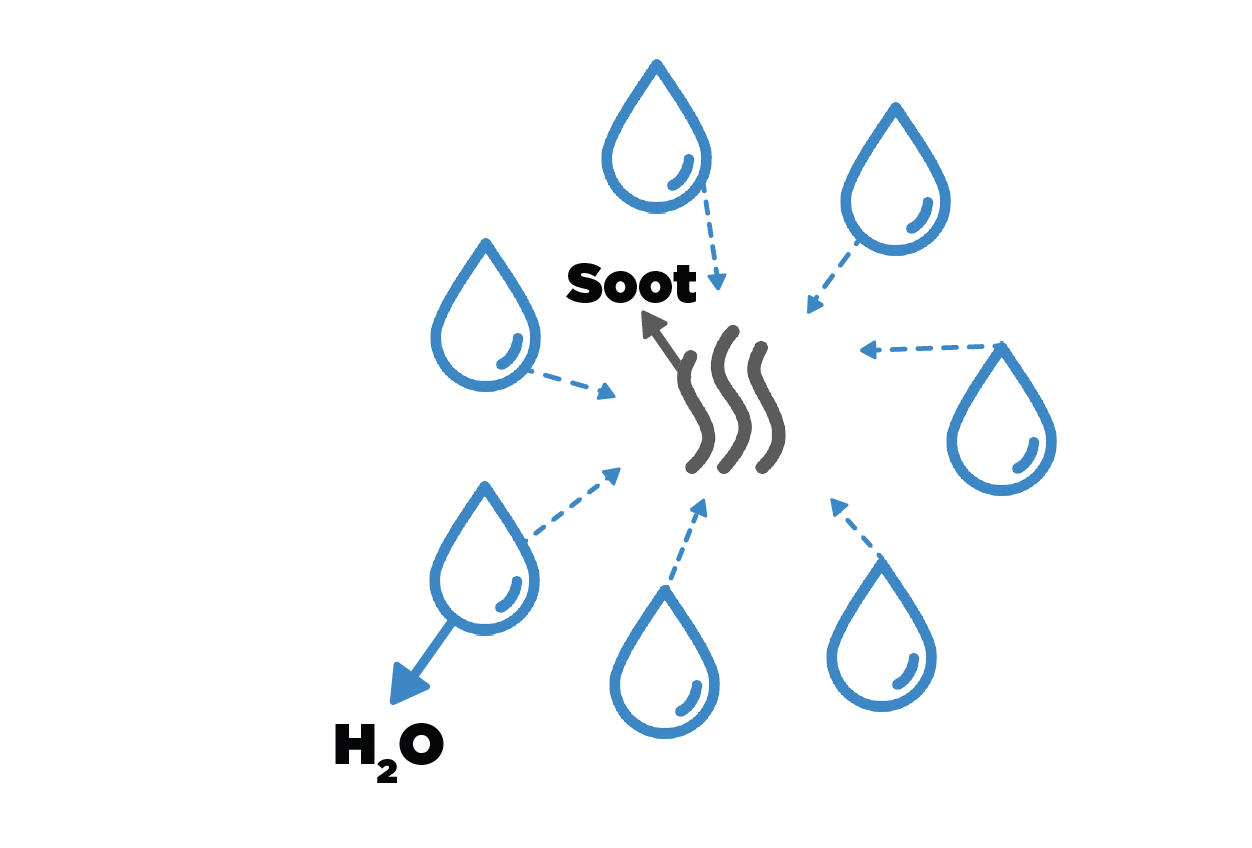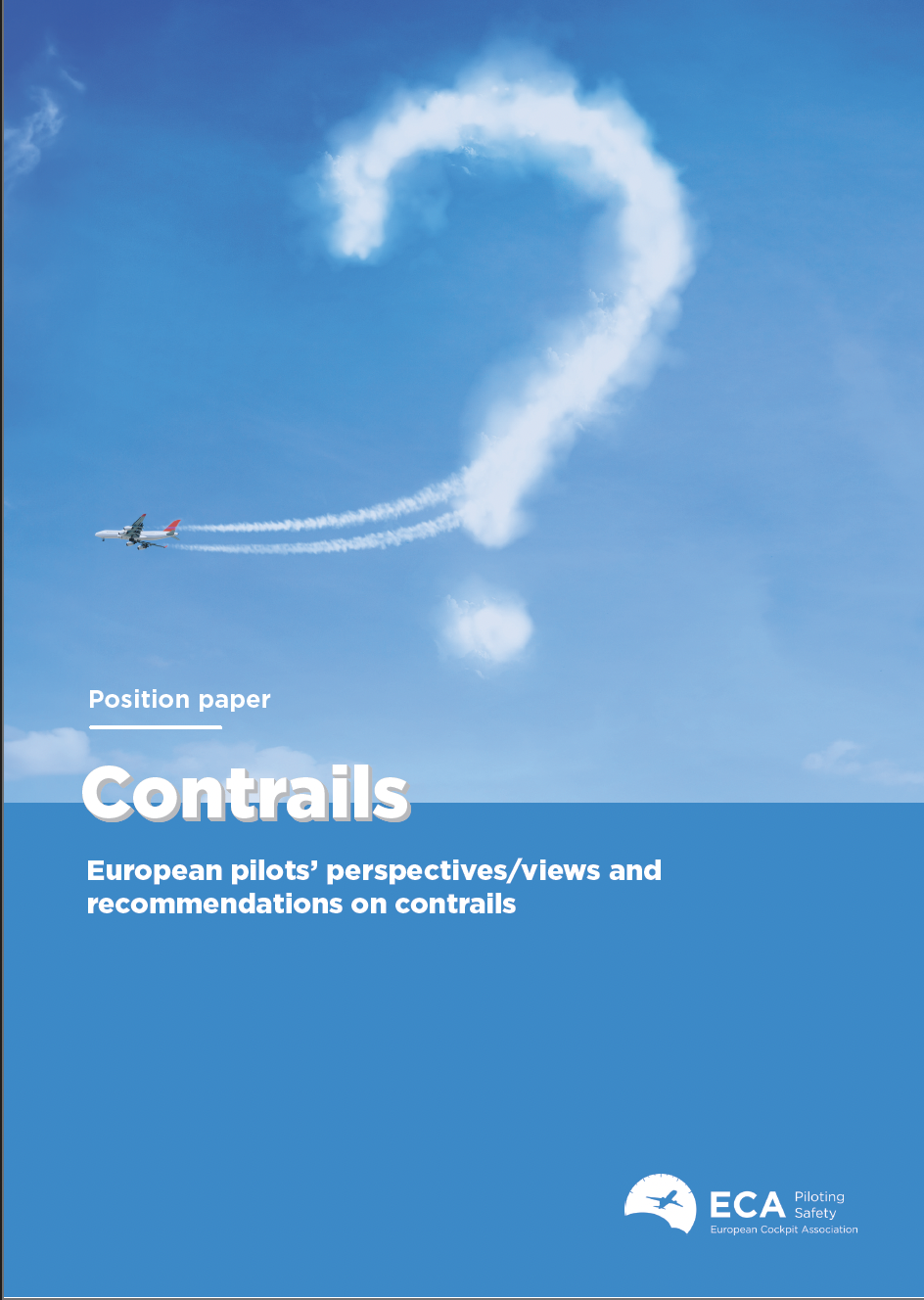European Cockpit Association publishes paper on contrails

Contrails: European pilots’ perspectives/views and recommendations on contrails
European pilots are committed to the goals of the European Green Deal and take the climate change challenge very seriously. On behalf of the European pilots’ community, in June 2022 ECA released a comprehensive position paper on environment ‘Securing a sustainable future for aviation: The pilots’ perspective’ in which pilots offered their unique operational expertise to help shape aviation decarbonisation solutions and the implementation thereof from a flight deck perspective.
“It is ECA’s ambition to promote new operational practices and procedures bringing environmental gains. European pilots are ready to contribute concretely, in their own remit, to the collective effort to reduce aviation environmental footprint.”
Spot on contrails
The focus of governments in Europe and worldwide has been to reduce CO2 emissions with an ambitious target of climate neutrality by 2050. In parallel, the aviation ‘eco-system’ is looking at other impacts on climate and well-being such as air quality, noise, and non-CO2 emissions.
Besides CO2, planes also emit oxides of nitrogen (NOx), soot particles, sulfur dioxide (SO2), sulfate aerosols, and water vapor.
Some of these exhaust products may produce “contrails”1. These by-products arising from burning jet fuels fall altogether under the category of aviation non-CO2 emissions. The impacts of aviation non-CO2 emissions on the climate are complex and not fully understood but estimated to be 2 to 3 times higher than those of CO2 emissions2 which is why they deserve attention.
EASA3 estimates that the largest non-CO2 impacts are from ‘net-NOx’4 and contrail cirrus5, although significant uncertainties prevail about the magnitude of these impacts.6
Can and should contrails be avoided?
Acknowledging climate impacts of non-CO2 emissions and contrails in particular, the question at stake is whether formation of contrails can and should be avoided. The conduct of the world-wide first operational trial on the avoidance of contrails by EUROCONTROL and the German Aerospace Center (DLR)7 carried out over a period of 10 months in 2021 in the Maastricht Upper Area Control Center (MUAC) caught ECA’s attention.
The European pilots’ community took a close interest in the findings of the trial which appeared to confirm that contrails could be avoided in principle. However, a number of improvements is required to tackle existing limitations (e.g. ISSR/Ice Super Saturated Region prediction not reliable; verification of contrails via geo stationary satellite images rather difficult; effect of contrail prevention versus increased CO2 emissions needs to be further investigated)8. It is also to be noted that the trial was conducted during a situation of low traffic (COVID) and the impact of contrails avoidance in a high traffic scenario requires further investigation.
European pilots’ position
ECA takes note of the recent decision of the European policymakers to make it mandatory for airlines to start reporting non-CO2 emissions (including contrails) via Monitoring, Reporting and Verification (MRV) tool as of 2025.
This creates an urgent need to minimise scientific uncertainties over the magnitude of the effects of non-CO2 emissions and to fill the gap in the scientific understanding about contrails prevention through additional studies, investigations, and research activities.
Until these objectives are met, the pilots’ community calls for a sensible and prudent approach regarding contrails formation, avoidance, and management to ensure ‘no regret’ policies are rolled-out. Similar calls resonate in some parts of the scientific community:
“Rather than decreasing aviation’s climate impact, premature implementation of the navigational avoidance strategy risks increasing it. Beyond this, we have no robust mechanism for confidently verifying its efficacy.” 9
In this context, European pilots are ready to actively participate in future research activities aiming at further establishing data and knowledge on the non-CO2 effects of aviation and assessing relevant courses of actions.
More specifically European pilots see the need for the following scientific clarifications and technological progress in order to achieve real environmental (net) gains from contrails avoidance:
1. Developing more reliable numerical weather forecasting
- Better tools for Ice Super Saturated Regions (ISSR) prediction and detection (installing avionics relative humidity sensors on aircraft fuselage)
- Better tools for persistent contrails prediction and real-time contrails validation (for example satellite and ground-based sky-cams)
2. Agreeing on appropriate climate functions which will efficiently compute the effects of non-CO2 emissions as an equivalent to CO2 emissions. Such ecoefficiency computations must take into account the full complexity of the non- CO2 phenomena (e.g. warming and cooling effects of contrail cirrus clouds) with the ultimate goal of minimizing the overall climate impact
3. Burning extra fuel for avoiding contrails is seen by some scientists as a real risk10 which could cause more harm to the environment than good. Such tradeoffs should therefore be carefully assessed. Broad consensus within the scientific community on the topic is crucial to make well-informed decisions
4. Carrying out additional research activities to quantify the overall climate impacts of jet fuels quality and type (reduction of aromatics/sulfur concentration11 or replacement by Sustainable Aviation Fuels). If confirmed, the research should also look into the feasibility of targeted low aromatics fuel/SAF use for ‘highimpact flights’ (flight routes predicted to cross ISSR). In addition, more incentives should be provided to scale up production of SAF at an affordable price
5. Develop flight planning tools for operators and ANSPs to incorporate a flexible concept of operations to enable preferably strategic or pre-tactical interventions for contrail avoidance with a minimal impact on air traffic operations and air space capacity. If in-flight tactical interventions need to be made, safety must not be compromised

Download the Position Paper here: Contrails: European pilots’ perspectives/views and recommendations on contrails, Position Paper 2023
1. Contrails or ‘condensation trails’ are line-shaped clouds which can be seen in certain altitudes in the skies behind airborne aircraft. These linear clouds are formed by water vapor in combination with soot and sulfur gases that come out of jet engine exhaust. (See: U.S. Environmental Protection Agency: ‘Aircraft Contrails Factsheet’, September 2000,
2. Lee, D.S. et al.: ‘The contribution of global aviation to anthropogenic climate forcing for 2000 to 2018’, September 2020, URL: The contribution of global aviation to anthropogenic climate forcing for 2000 to 2018 | Elsevier Enhanced Reader
3. EASA report: ‘Updated analysis of the non-CO2 effects of aviation’, September 2020,
4. Ed. NOx causes chemical disbalances in the atmosphere which have radiative effects.
5. Ed. Contrail cirrus is persistent contrails which have been observed to lead to the formation of extensive cirrus clouds.
6. Op. Cit. Lee, D.S. et al.: ‘The contribution of global aviation to anthropogenic climate forcing for 2000 to 2018’
7. German Aerospace Center (DLR): ‘Preventing contrails with the right flight altitude’, 3 November 2021
8. EUROCONTROL & Maastricht Upper Area Control (member of FABEC), Contrail prevention: ‘Mitigating the climate impact of non-CO2 emissions: EUROCONTROL MUAC Live Trial 2021’
9. Keith Shine and David Lee: ‘Commentary – Navigational avoidance of contrails to mitigate aviation’s climate impact may seem a good idea – but not yet’, 21 July 2021
10. Op.Cit. Keith Shine and David Lee: ‘Commentary – Navigational avoidance of contrails to mitigate aviation’s climate impact may seem a good idea – but not yet’
11. Ulrike Burkhardt, Lisa Bock and Andreas Bier: ‘Mitigating the contrail cirrus climate impact by reducing aircraft soot number emissions’, NPJ Climate and Atmospheric Science, 19 October 2018

.png)
.jpg)






Comments
There are no comments yet for this item
Join the discussion